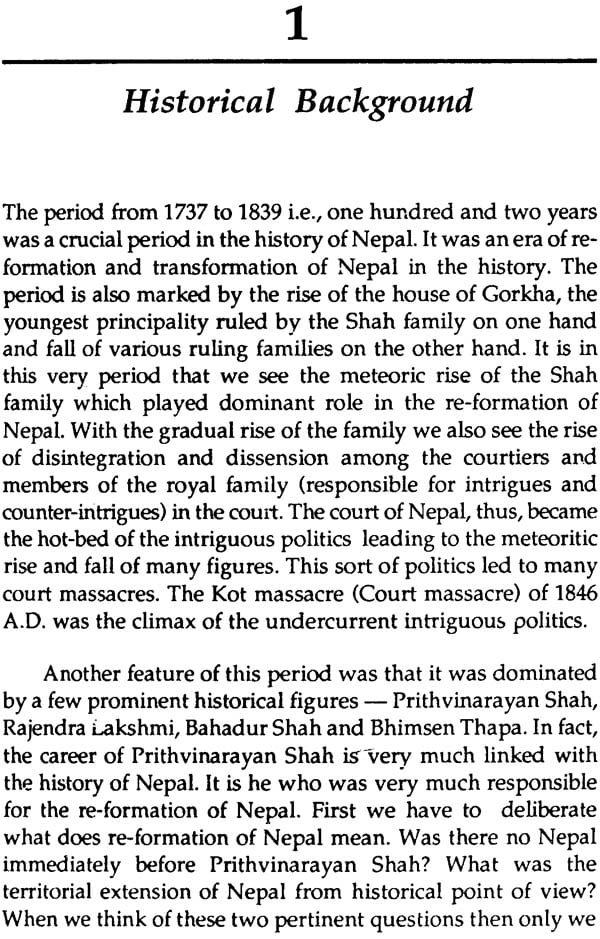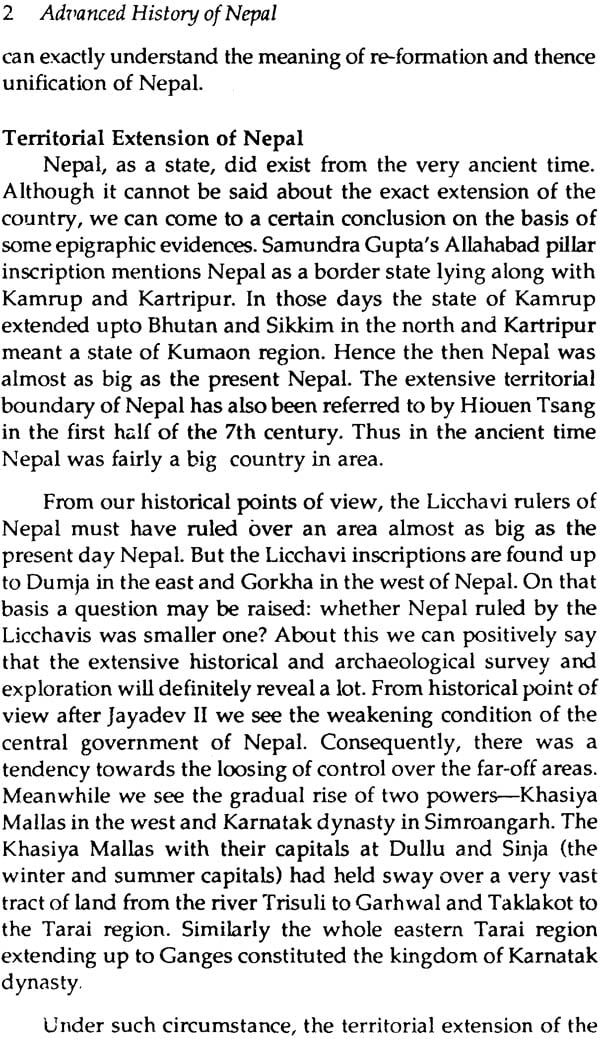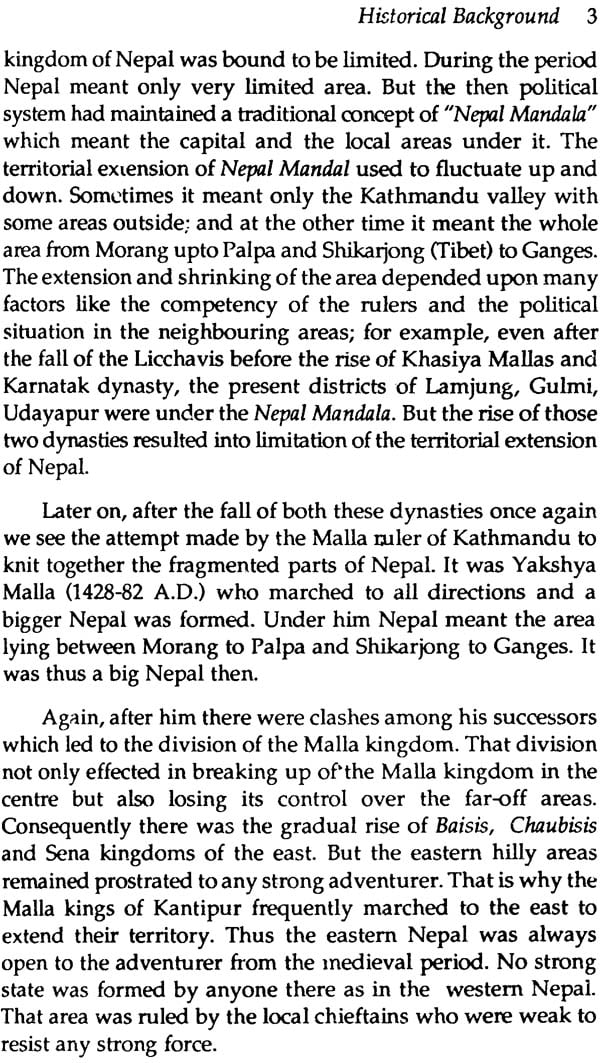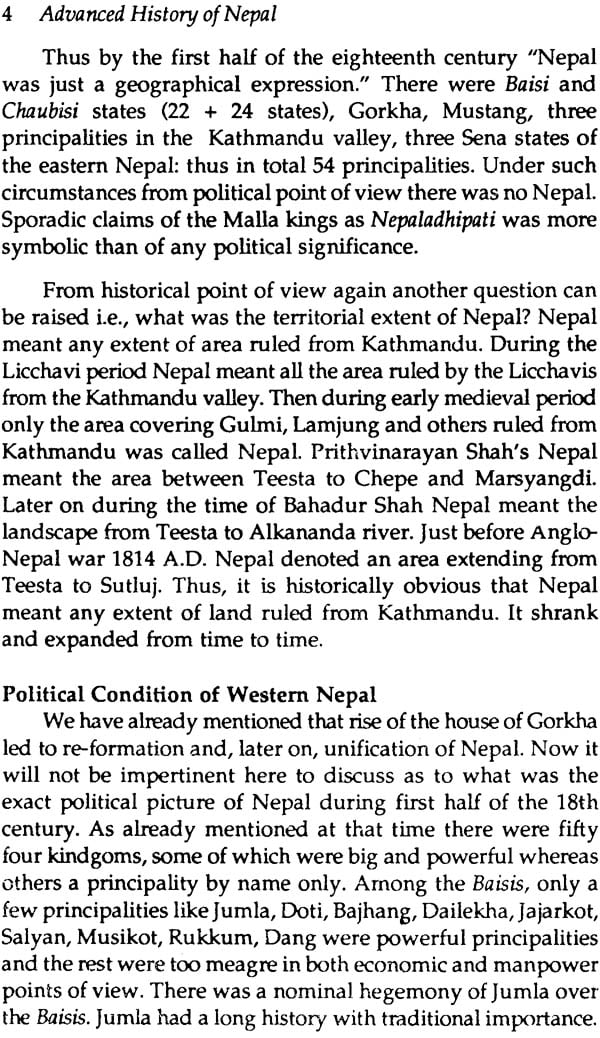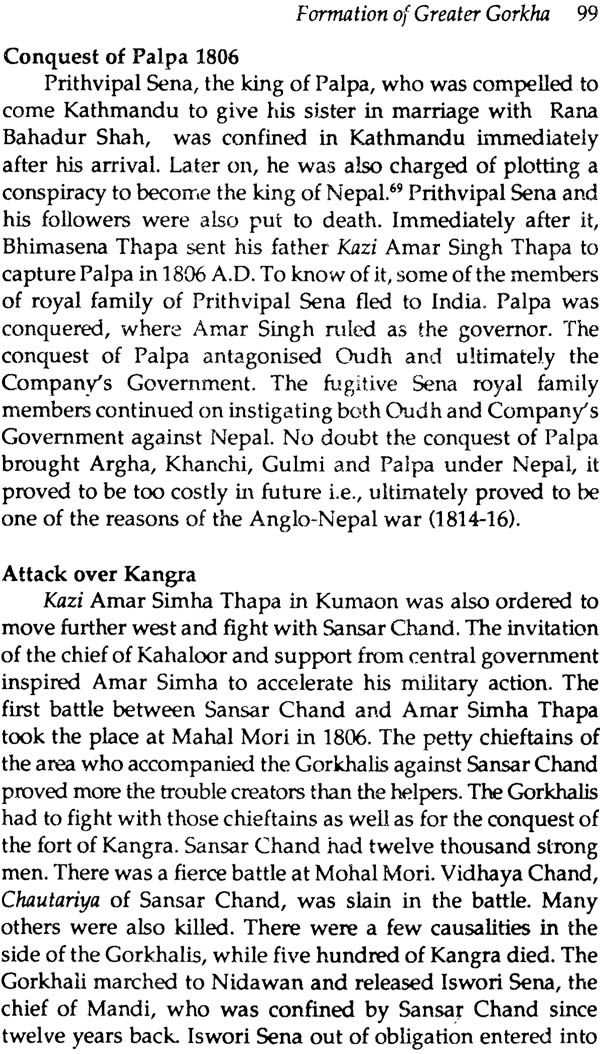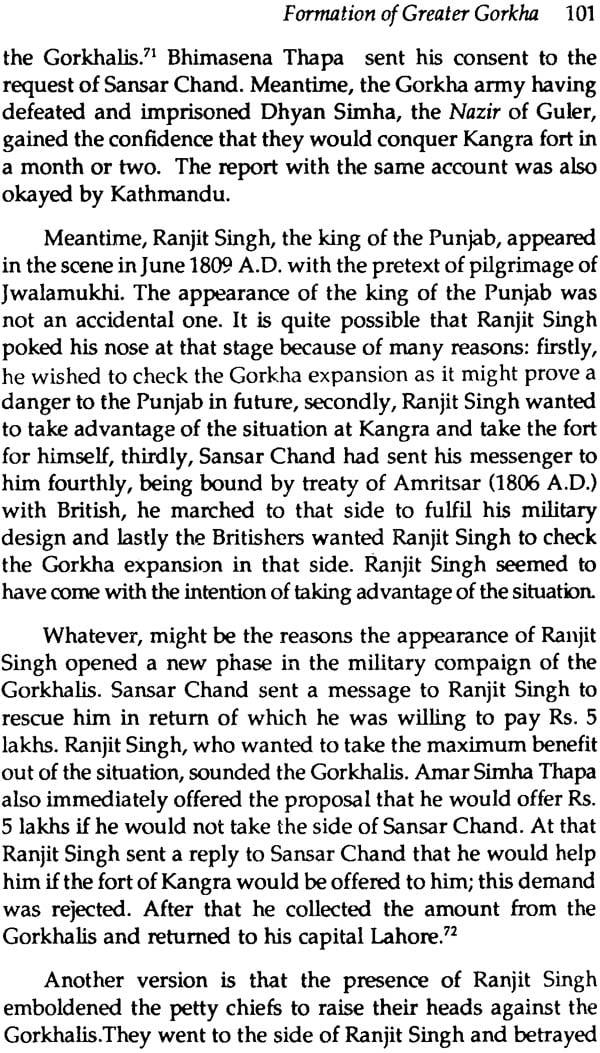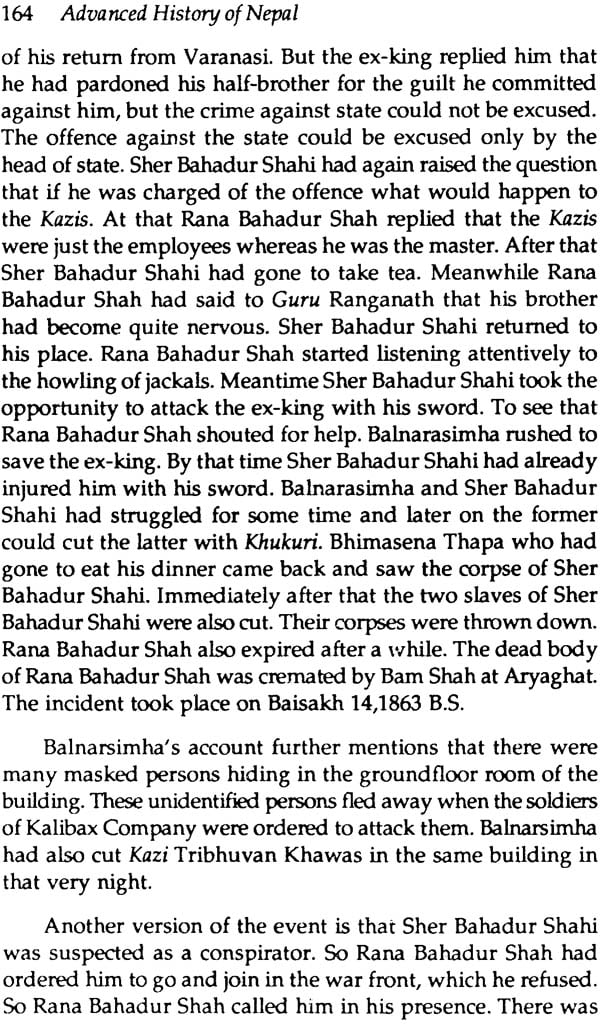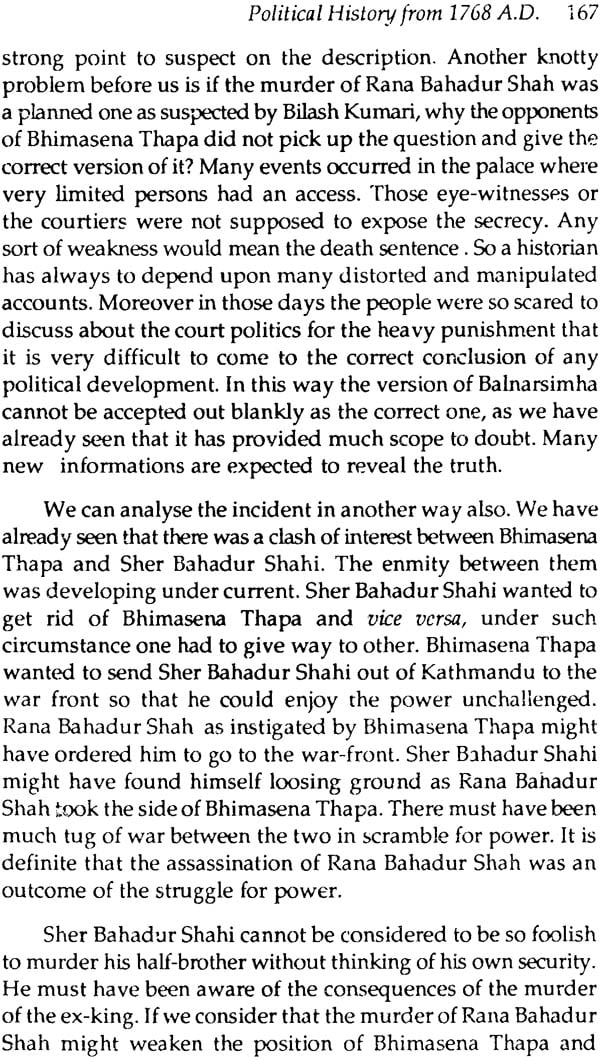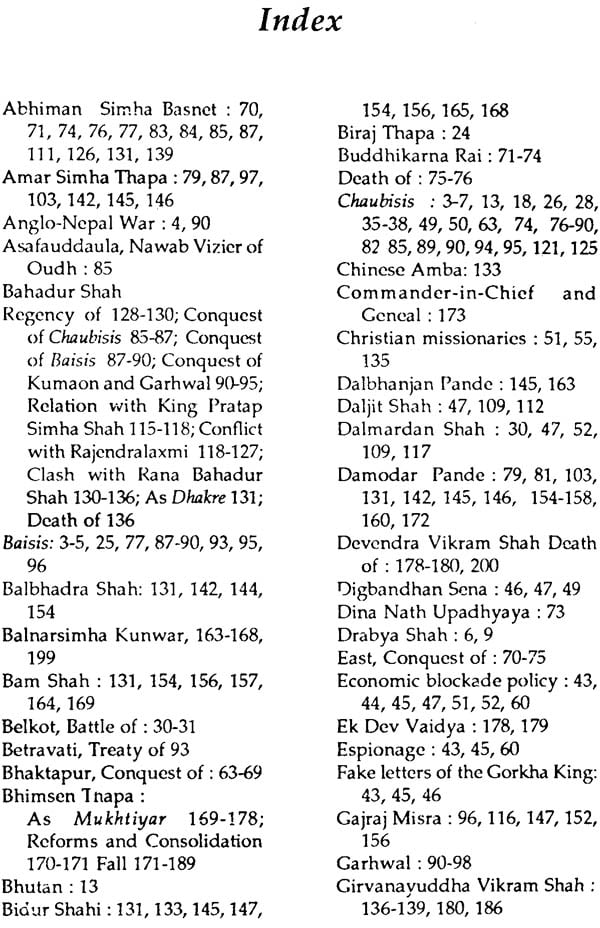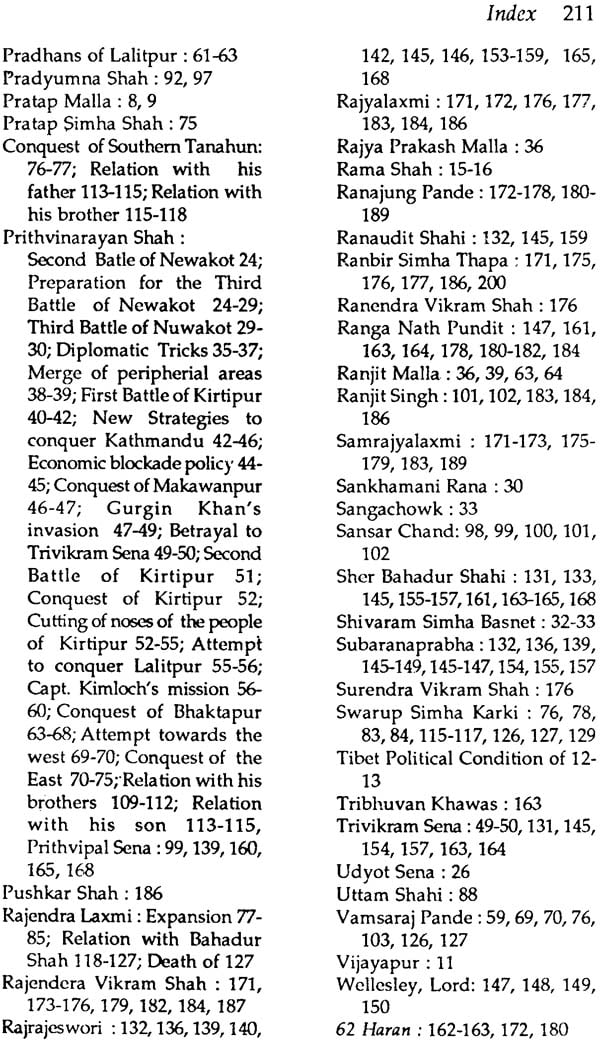
Advanced History of Nepal (1737-1839)
Book Specification
| Item Code: | NAM337 |
| Author: | T. R. Vaidya |
| Publisher: | Anmol Publications Pvt Ltd |
| Language: | English |
| Edition: | 2001 |
| ISBN: | 8170419972 |
| Pages: | 225 |
| Cover: | Hardcover |
| Other Details | 9.0 inch x 6.0 inch |
| Weight | 400 gm |
Book Description
The present book deals with two important aspects of the history of Nepal: One the expansion of Gorkha which unwittingly ultimately led to the formation of modern Nepal; and the other the tracing of the long history of the conspiratory politics of the court of Nepal. Both the events were of much importance in the history as they were most important epoch-making events.
During the 18th century, Nepal was just "a geographical expression not a political entity." Such a small country also was divided into fifty four petty principalities some of which were too meagre to be called a state and had a few thatched huts. The joint family system had its impact on the polity as its result many times the kingdom was divided among the issues of a king as the ancestral property. Moreover, the lack of unity among the descendants of the same family also led to the disintegration of the big kingdoms like those of Senas and Mallas. Thus, when Nepal was shattered into pieces, there emerged a small and youngest principality which shouldered the burden of uniting the divided political units into one bigger state. That burden was borne by Gorkha.
Gorkha, although the youngest among the states in the western Nepal, was made strong, well determined and daring by its history. The centuries old struggle for its existence against Lamjung had made the nation militant, cemented the relation between the ruler and ruled, and determined to do something. In this context rulers like Rama Shah, Prithvipati Shah and others had contributed a lot in the growth of the state. Rama Shah became the forerunner of Prithvinarayan Shah in the of expansion of Gorkha empire. The poverty stricken and outcastes were looked down upon by next door neighbours and humiliated Gorkha sought a new way for its growth and development. Gorkha made the glorious history under the competent ruler like Prithvinarayan Shah.
Dr. T.R. Vaidya (b. 1940) obtained his M.A. and Ph.D. from Allahabad University in 1960 and 1974 respectively. Formerly, Head of Central Department of History, and Ex- Dean, Faculty of Humanities and Social Sciences, Tribhuvan University, Kathmandu, Professor Vaidya is a seasoned teacher having over three decades professional standing. Presently Dr. Vaidya is Controller of Examinations, Tribhuvan University, Kathmandu (Nepal).
There is no dearth of the books on the History of Modern Nepal. But most of the books were written prior to the restoration of democracy i.e. 1990 A.D., during which the local scholars could not enjoy full academic freedom. The historians were not free from the then political system; they were either much in its support or very much biased. In this work I have tried to be an impartial one in presenting the subject in its proper historical perspective.
The period i.e. 1737 to 1839 A.D. (a century) is one of the most eventful in the history of Nepal.In this work emphasis is placed on mainly two aspects i.e., the expansion of the Gorkha state and the political history of the period.
During the first half of the 18th century Nepal did not exist as a "political entity" and was considered just merely "a geographical expression." It was divided into several petty states, each having a confrontation with the next door neighbour. At such a time an adventurous and enterprising person, Prithvinarayan Shah, king of Gorkha, came forward to expand his kingdom which covered barren mountains, had no mineral resources, and was not much agriculturally productive and did not have any trade prospect.
Although looked down upon by powerful neighbourly states, poverty stricken, humiliated even by the relative royal family members of other states, the unity between the ruling house and the people became the most potential factor to expand Gorkha for the better economic prospect of the Gorkhali ruling family and the poverty stricken courtiers. The prosperity and clashes among the Malla rulers of the Kathmandu Valley had tempted Prithvinarayan Shah to move towards the east. Thus the said king, assuring better prospect to his followers, made an expansion of Gorkha which uwittingly led to the Unification of Nepal. To him end justified the means. Many atrocities were committed but he succeeded in conquering the eastern Nepal and became the founder of modern Nepal.
His work was further pushed ahead by his daughter-in-law Rajendra Laxmi and his younger son Bahadur Shah during their regencies later on when king Rana Bahadur Shah was of minor age. The expansion of Gorkha was also indirectly helped by the political situation then prevalent in India. The British Government in India was terribly busy in the wars with Mysore, Marathas and others. So it could not come forward to rescue the vanquished rulers of the different states of Nepal, who sought help from the Company's Government. In the compaign for expansion, the Gorkhalis had committed many horrible atrocities in the conquered areas some of which were almost depopulated either because the people deserted their villages or a large number of people were taken as 'prisoners to be sold as slaves by the Gorkhali officers as the people could not pay the exorbitant taxes imposed on them by the officers. The British government in India waited for an opportune time to check the rising power of Gorkha. Once the British Government was relieved by the utter failure of Napoleon I in his Moscow expedition, it took step against Nepal which led to the Anglo-Nepalese War 1814-16 A.D.; after which Nepal and Company government became friendly. As a result of this war Nepal got its present shape (excluding four districts of the far western part which were restored to Nepal during the rule of Jang Bahadur Rana.
Politically this period witnessed many heart thrilling, horrible and sanguine plots and counter-plots. Prithvinarayan Shah had said that the Kathmandu Valley was a cold stone where only intrigues and counter-intrigues took place. He had said it on the basis of what he had personally observed and experienced in the Kathmandu Valley during the Malla period. So he wanted to have his capital on a hill-top called Dahachowk in the west of Kathmandu. But he himself could not do away with the conspiratorial politics. His own brothers and eldest son - the crown prince did not pull on well with him during his last days.
After the death of Prithvinarayan Shah the court of Nepal became the hot-bed of conspiratorial politics. There were clashes among the royal family members specially among the queens and concubines, so was the case among the courtiers. The courtiers left no stone to win the favour of the king and untorned grab power. Such situation resulted into cold blooded murders of many potential courtiers. Even Rana Bahadur Shah, the ex-king, was killed by his half brother Sher Bahadur Shah.
The opportunity was exploited by Bhimsen Thapa, Rana Bahadur Shah's confidential courtier. He put many influential courtiers and others, guilty or innocent, to death to set aside those people who could come on his way. Thus he sat on the chair stained by the blood of those killed in the most cold blooded manner. Although he had committed such an atrocity he restored law and order for about three decades. He fought with the British and at the same time consolidated the country administratively. But his heydays also did not last long.
Bhimsen Thapa, who ruled the country as the de facto ruler from 1806-37, met his fall from 1832 step and step. At last he was dismissed, chained, handcuffed, and imprisoned on a false charge. Although acquitted as the charges labelled against him could not be proved he was again imprisoned and compelled to commit suicide in 1839. It is most likely that he was murdered in prison and spread the rumour that he committed suicide.
The period from 1737 (first battle of Nuwakot! to 1839 (suicide of Bhimsen Thapa) is thus most eventful period in the history of Nepal.
| Acknowledgement | vii | |
| Preface | ix | |
| 1 | Historical Background | 1 |
| 2 | Formation of Greater Gorkha | 20 |
| 3 | Political History from 1768 AD | 108 |
| 4 | Conclusion | |
| Selected Bibliography | 203 | |
| Index | 209 |
